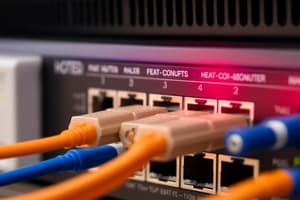Podcast
Questions and Answers
The administrative distance for directly connected routes is ______.
The administrative distance for directly connected routes is ______.
0
A static route has an administrative distance of ______.
A static route has an administrative distance of ______.
1
The administrative distance for External BGP is ______.
The administrative distance for External BGP is ______.
20
RIP has an administrative distance of ______.
RIP has an administrative distance of ______.
OSPF has an administrative distance of ______.
OSPF has an administrative distance of ______.
Static routes are commonly used as a default route forwarding packets to a ______.
Static routes are commonly used as a default route forwarding packets to a ______.
Dynamic routing protocols allow for automatic updates while static routes are defined by the ______.
Dynamic routing protocols allow for automatic updates while static routes are defined by the ______.
Internal EIGRP has an administrative distance of ______.
Internal EIGRP has an administrative distance of ______.
Static routes are useful for smaller networks with only ______ path to an outside network.
Static routes are useful for smaller networks with only ______ path to an outside network.
Static and dynamic routing are not mutually ______.
Static and dynamic routing are not mutually ______.
When a router receives an IP packet on one interface, it determines which interface to use to ______ the packet to the destination.
When a router receives an IP packet on one interface, it determines which interface to use to ______ the packet to the destination.
The primary functions of a router are to determine the best path to ______ packets based on the information in its routing table.
The primary functions of a router are to determine the best path to ______ packets based on the information in its routing table.
Each network that a router connects to typically requires a separate ______.
Each network that a router connects to typically requires a separate ______.
A router uses its IP routing table to determine which path (route) to use to ______ a packet.
A router uses its IP routing table to determine which path (route) to use to ______ a packet.
Static and ______ routing involve different methods of managing routing paths in a network.
Static and ______ routing involve different methods of managing routing paths in a network.
The interface that the router uses to forward the packet may be the final ______, or it may be a network connected to another router.
The interface that the router uses to forward the packet may be the final ______, or it may be a network connected to another router.
Routers determine the best path based on the information in its ______.
Routers determine the best path based on the information in its ______.
In the example of routers R1 and R2, each will use their respective IP routing ______ to determine the best path.
In the example of routers R1 and R2, each will use their respective IP routing ______ to determine the best path.
Dynamic routing protocols are implemented in any type of network consisting of more than just a few ______.
Dynamic routing protocols are implemented in any type of network consisting of more than just a few ______.
Dynamic routing protocols are scalable and automatically determine better routes if there is a change in the ______.
Dynamic routing protocols are scalable and automatically determine better routes if there is a change in the ______.
As the network grows, the dynamic routing protocol automatically learns about any new ______.
As the network grows, the dynamic routing protocol automatically learns about any new ______.
Static routing increases in configuration ______ with network size.
Static routing increases in configuration ______ with network size.
Dynamic routing automatically adapts to topology ______ changes.
Dynamic routing automatically adapts to topology ______ changes.
Dynamic routing is suitable for simple to complex network ______.
Dynamic routing is suitable for simple to complex network ______.
For security in dynamic routing, it must be ______ to ensure proper configurations.
For security in dynamic routing, it must be ______ to ensure proper configurations.
Static routing does not use additional ______ such as CPU or memory resources.
Static routing does not use additional ______ such as CPU or memory resources.
In dynamic routing, the path depends on ______ and the routing protocol used.
In dynamic routing, the path depends on ______ and the routing protocol used.
Static routing paths are explicitly defined by the ______.
Static routing paths are explicitly defined by the ______.
The ______ determines the best path for packets to travel in a network.
The ______ determines the best path for packets to travel in a network.
The command to create a static route is ______ followed by the destination address.
The command to create a static route is ______ followed by the destination address.
In IPv6, the command for a default route is ______.
In IPv6, the command for a default route is ______.
Load balancing can be categorized into equal-cost and ______ load balancing.
Load balancing can be categorized into equal-cost and ______ load balancing.
IS-IS is utilized for ______ routing protocols.
IS-IS is utilized for ______ routing protocols.
A directly connected network is added to the routing table when an interface is configured with an IP address and ______ length.
A directly connected network is added to the routing table when an interface is configured with an IP address and ______ length.
Routers learn about remote networks through ______ routes and dynamic routing protocols.
Routers learn about remote networks through ______ routes and dynamic routing protocols.
After determining the correct path, a router can forward the packet on a directly connected network, to a ______ router, or drop the packet.
After determining the correct path, a router can forward the packet on a directly connected network, to a ______ router, or drop the packet.
Routers support three packet forwarding mechanisms: process switching, fast switching, and ______.
Routers support three packet forwarding mechanisms: process switching, fast switching, and ______.
The source of routing table information is derived from directly connected networks, static routes, and ______ routing protocols.
The source of routing table information is derived from directly connected networks, static routes, and ______ routing protocols.
Every router makes its decision based on the information in its own ______ table.
Every router makes its decision based on the information in its own ______ table.
Routing table entries include the route source, destination network, AD, metric, next-hop, route timestamp, and exit ______.
Routing table entries include the route source, destination network, AD, metric, next-hop, route timestamp, and exit ______.
A default route specifies a next-hop router to use when the routing table does not contain a specific ______ that matches the destination IP address.
A default route specifies a next-hop router to use when the routing table does not contain a specific ______ that matches the destination IP address.
Dynamic routing protocols can discover a network, maintain routing tables, select a best path, and automatically discover a new best path if the ______ changes.
Dynamic routing protocols can discover a network, maintain routing tables, select a best path, and automatically discover a new best path if the ______ changes.
IPv4 routing tables still have a structure based on ______ addressing represented by levels of indentation.
IPv4 routing tables still have a structure based on ______ addressing represented by levels of indentation.
Flashcards are hidden until you start studying
Study Notes
Module Overview
- Focus on routing concepts within Switching, Routing, and Wireless Essentials v7.0.
- Objectives include packet forwarding, path determination, basic router configuration, and comparing static and dynamic routing.
Path Determination
- Routers determine the best path to forward packets using information from IP packets and their routing tables.
- Each interface on the router typically connects to a separate network; the router decides whether to send packets directly to the destination or via another router.
Router Functions
- Primary functions include determining the best forwarding route and sending packets towards their destination.
- The IP routing table is crucial for path determination.
IP Routing Table
- Contains entries for various routing protocols and their Administrative Distances (ADs):
- Directly connected: 0
- Static route: 1
- EIGRP summary route: 5
- Internal EIGRP: 90
- OSPF: 110
- RIP: 120
- Internal BGP: 200
Static vs. Dynamic Routing
-
Static Routing:
- Static routes are explicitly defined by an administrator.
- Commonly used as default routes, for stub networks, or to secure traffic in larger networks.
- Useful for smaller networks with predictable paths, increases configuration complexity with more routers.
-
Dynamic Routing:
- Automatically adapts to changes in network topology.
- Scalable and preferred in networks with many routers, as it learns and updates routes automatically.
Comparison of Static and Dynamic Routing
- Configuration Complexity:
- Dynamic routing adapts regardless of network size; static routing complexity increases with network size.
- Adaptation to Topology Changes:
- Dynamic protocols handle changes automatically; static routing requires manual updates.
- Scalability:
- Dynamic is suitable for complex networks, while static is for simpler topologies.
- Security:
- Static inherently provides more security; dynamic requires configuration.
- Resource Usage:
- Dynamic routing uses more CPU and memory resources compared to static routing, which requires none.
Packet Forwarding Mechanisms
- Routers can use process switching, fast switching, or Cisco Express Forwarding (CEF) to forward packets.
Routing Table Entries
- Include source, destination network, Administrative Distance, metrics, next-hop information, and exit interfaces.
- Static routes must be manually configured, whereas dynamic routes are learned via protocols that can adapt to topology changes.
New Terms and Commands
- Important terms include Administrative Distance, default route, prefix length, next-hop router, and various routing protocols such as BGP, EIGRP, OSPF, and IS-IS.
- Commands used for router configurations include
ip route,ipv6 route,show ip route, and others related to routing and interface management.
Studying That Suits You
Use AI to generate personalized quizzes and flashcards to suit your learning preferences.




